Leadership and Operations at Ford Motors: A Detailed Analysis
VerifiedAdded on 2021/02/20
|16
|5165
|117
Report
AI Summary
This report provides a comprehensive analysis of leadership and management practices within Ford Motors. It begins with an introduction to the company, its organizational structure, and the roles and characteristics of leaders versus managers. The report distinguishes between the functions of managers and the roles of leaders, illustrating these differences with real-world situations such as decision-making, employee engagement, and technology upgrades. It then explores various leadership theories and models, including situational leadership, contingency leadership, and system leadership, evaluating their strengths and weaknesses in the context of Ford Motors. The assignment also delves into key operational approaches, the importance of operations management in achieving objectives, and the assessment of factors within the business environment that affect operational management. The report concludes by highlighting how leaders and managers can enhance operational efficiencies within the company. The assignment is a detailed exploration of the practical application of leadership and management principles within a global automotive company.
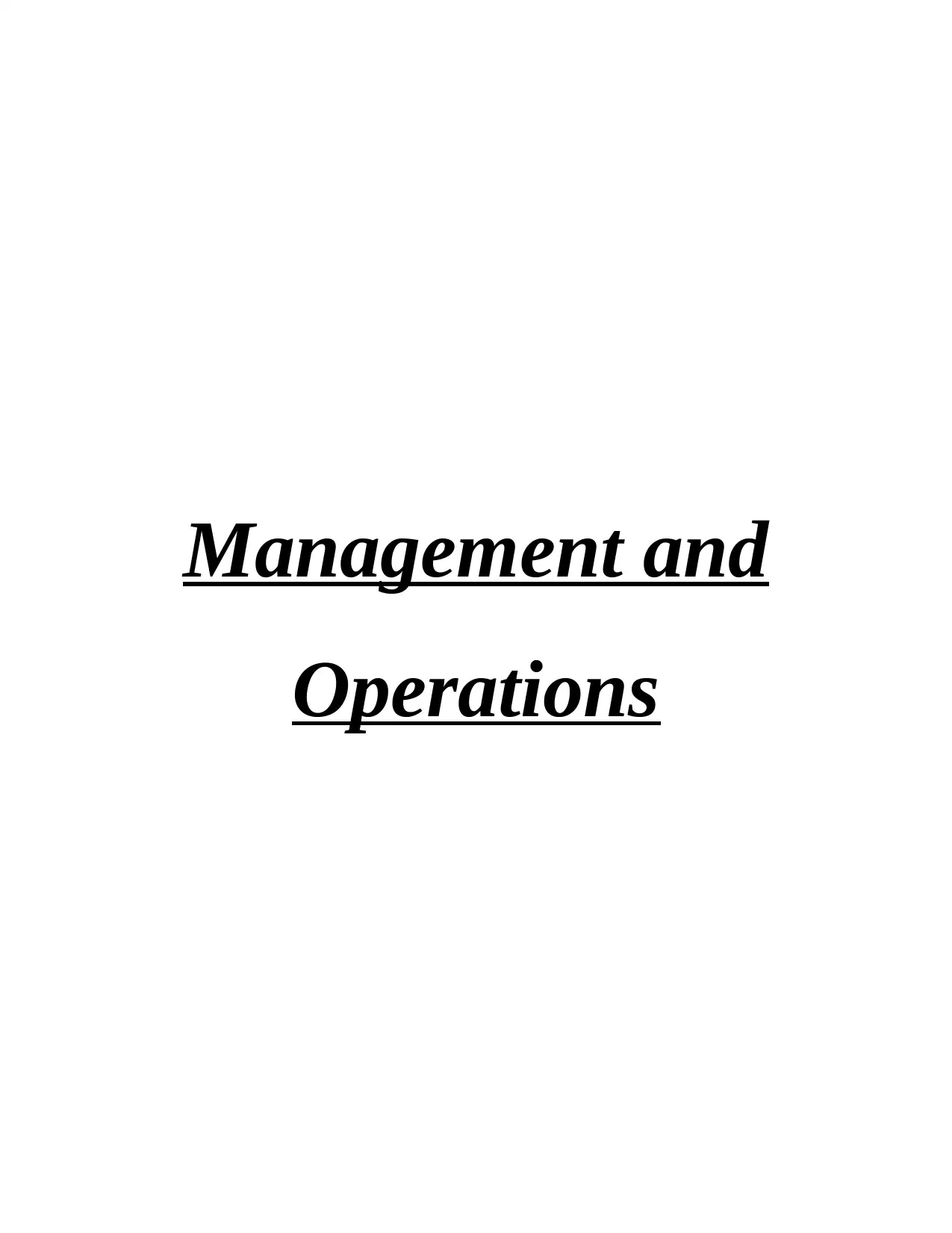
Management and
Operations
Operations
Paraphrase This Document
Need a fresh take? Get an instant paraphrase of this document with our AI Paraphraser
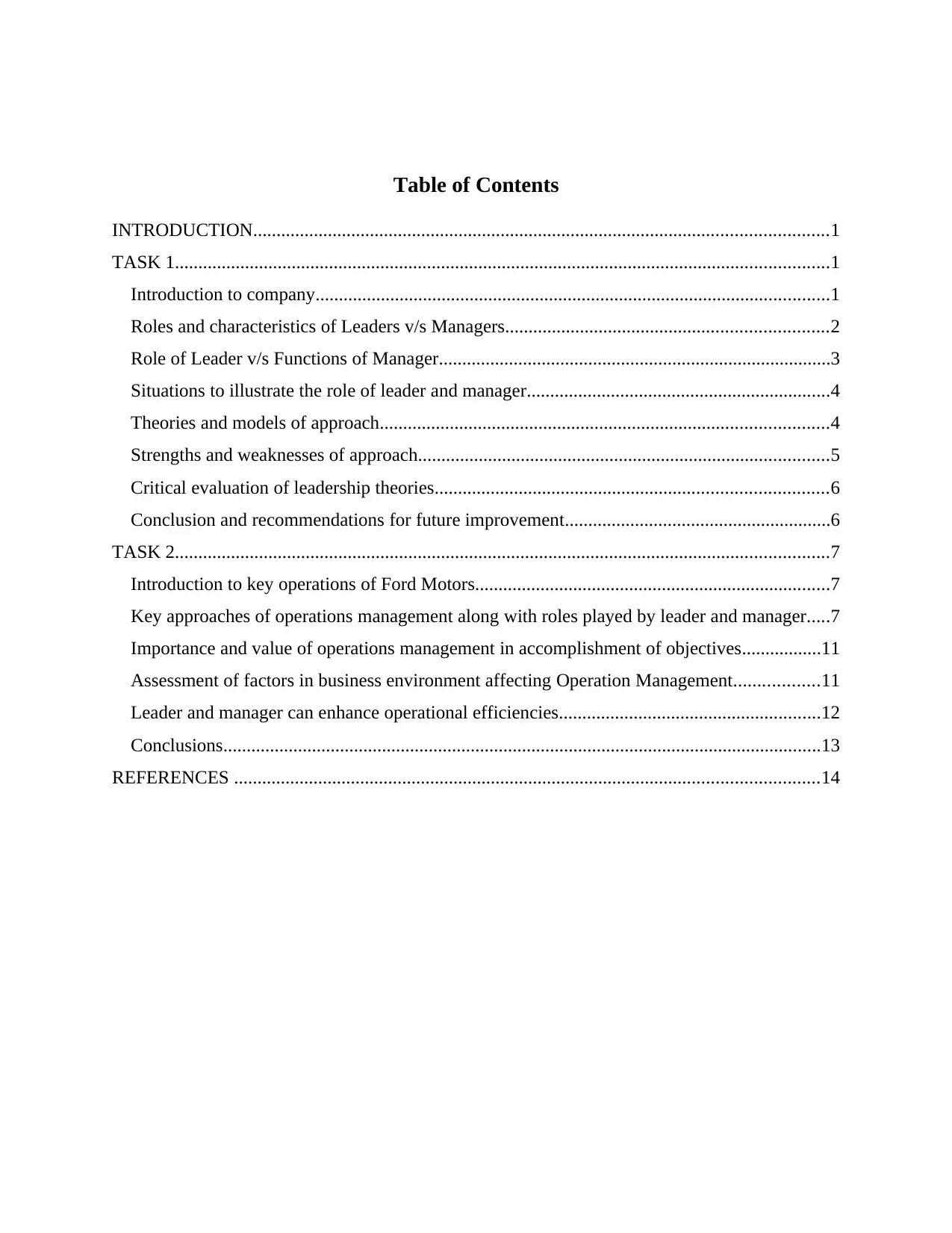
Table of Contents
INTRODUCTION...........................................................................................................................1
TASK 1............................................................................................................................................1
Introduction to company..............................................................................................................1
Roles and characteristics of Leaders v/s Managers.....................................................................2
Role of Leader v/s Functions of Manager....................................................................................3
Situations to illustrate the role of leader and manager.................................................................4
Theories and models of approach................................................................................................4
Strengths and weaknesses of approach........................................................................................5
Critical evaluation of leadership theories....................................................................................6
Conclusion and recommendations for future improvement.........................................................6
TASK 2............................................................................................................................................7
Introduction to key operations of Ford Motors............................................................................7
Key approaches of operations management along with roles played by leader and manager.....7
Importance and value of operations management in accomplishment of objectives.................11
Assessment of factors in business environment affecting Operation Management..................11
Leader and manager can enhance operational efficiencies........................................................12
Conclusions................................................................................................................................13
REFERENCES .............................................................................................................................14
INTRODUCTION...........................................................................................................................1
TASK 1............................................................................................................................................1
Introduction to company..............................................................................................................1
Roles and characteristics of Leaders v/s Managers.....................................................................2
Role of Leader v/s Functions of Manager....................................................................................3
Situations to illustrate the role of leader and manager.................................................................4
Theories and models of approach................................................................................................4
Strengths and weaknesses of approach........................................................................................5
Critical evaluation of leadership theories....................................................................................6
Conclusion and recommendations for future improvement.........................................................6
TASK 2............................................................................................................................................7
Introduction to key operations of Ford Motors............................................................................7
Key approaches of operations management along with roles played by leader and manager.....7
Importance and value of operations management in accomplishment of objectives.................11
Assessment of factors in business environment affecting Operation Management..................11
Leader and manager can enhance operational efficiencies........................................................12
Conclusions................................................................................................................................13
REFERENCES .............................................................................................................................14
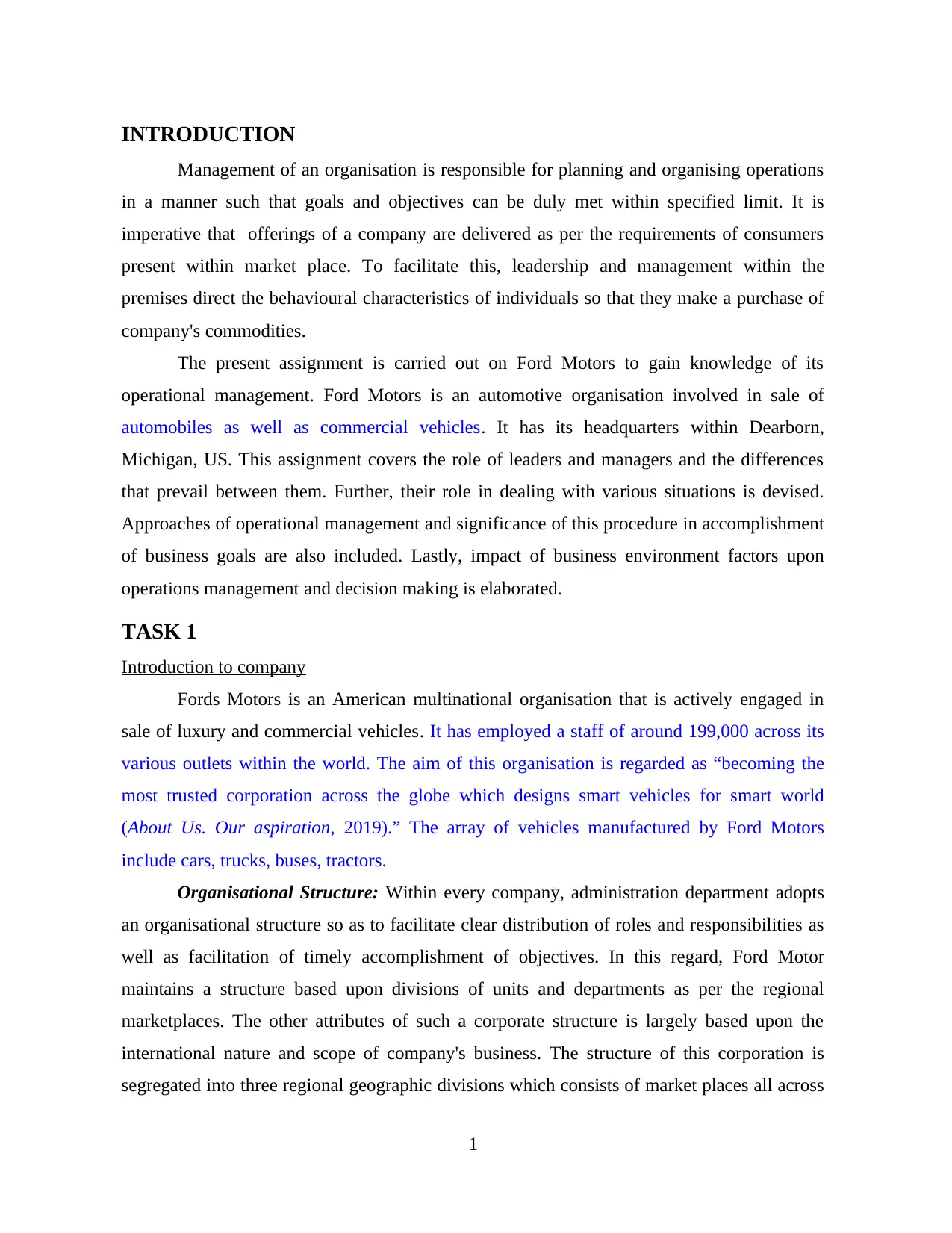
INTRODUCTION
Management of an organisation is responsible for planning and organising operations
in a manner such that goals and objectives can be duly met within specified limit. It is
imperative that offerings of a company are delivered as per the requirements of consumers
present within market place. To facilitate this, leadership and management within the
premises direct the behavioural characteristics of individuals so that they make a purchase of
company's commodities.
The present assignment is carried out on Ford Motors to gain knowledge of its
operational management. Ford Motors is an automotive organisation involved in sale of
automobiles as well as commercial vehicles. It has its headquarters within Dearborn,
Michigan, US. This assignment covers the role of leaders and managers and the differences
that prevail between them. Further, their role in dealing with various situations is devised.
Approaches of operational management and significance of this procedure in accomplishment
of business goals are also included. Lastly, impact of business environment factors upon
operations management and decision making is elaborated.
TASK 1
Introduction to company
Fords Motors is an American multinational organisation that is actively engaged in
sale of luxury and commercial vehicles. It has employed a staff of around 199,000 across its
various outlets within the world. The aim of this organisation is regarded as “becoming the
most trusted corporation across the globe which designs smart vehicles for smart world
(About Us. Our aspiration, 2019).” The array of vehicles manufactured by Ford Motors
include cars, trucks, buses, tractors.
Organisational Structure: Within every company, administration department adopts
an organisational structure so as to facilitate clear distribution of roles and responsibilities as
well as facilitation of timely accomplishment of objectives. In this regard, Ford Motor
maintains a structure based upon divisions of units and departments as per the regional
marketplaces. The other attributes of such a corporate structure is largely based upon the
international nature and scope of company's business. The structure of this corporation is
segregated into three regional geographic divisions which consists of market places all across
1
Management of an organisation is responsible for planning and organising operations
in a manner such that goals and objectives can be duly met within specified limit. It is
imperative that offerings of a company are delivered as per the requirements of consumers
present within market place. To facilitate this, leadership and management within the
premises direct the behavioural characteristics of individuals so that they make a purchase of
company's commodities.
The present assignment is carried out on Ford Motors to gain knowledge of its
operational management. Ford Motors is an automotive organisation involved in sale of
automobiles as well as commercial vehicles. It has its headquarters within Dearborn,
Michigan, US. This assignment covers the role of leaders and managers and the differences
that prevail between them. Further, their role in dealing with various situations is devised.
Approaches of operational management and significance of this procedure in accomplishment
of business goals are also included. Lastly, impact of business environment factors upon
operations management and decision making is elaborated.
TASK 1
Introduction to company
Fords Motors is an American multinational organisation that is actively engaged in
sale of luxury and commercial vehicles. It has employed a staff of around 199,000 across its
various outlets within the world. The aim of this organisation is regarded as “becoming the
most trusted corporation across the globe which designs smart vehicles for smart world
(About Us. Our aspiration, 2019).” The array of vehicles manufactured by Ford Motors
include cars, trucks, buses, tractors.
Organisational Structure: Within every company, administration department adopts
an organisational structure so as to facilitate clear distribution of roles and responsibilities as
well as facilitation of timely accomplishment of objectives. In this regard, Ford Motor
maintains a structure based upon divisions of units and departments as per the regional
marketplaces. The other attributes of such a corporate structure is largely based upon the
international nature and scope of company's business. The structure of this corporation is
segregated into three regional geographic divisions which consists of market places all across
1
⊘ This is a preview!⊘
Do you want full access?
Subscribe today to unlock all pages.

Trusted by 1+ million students worldwide
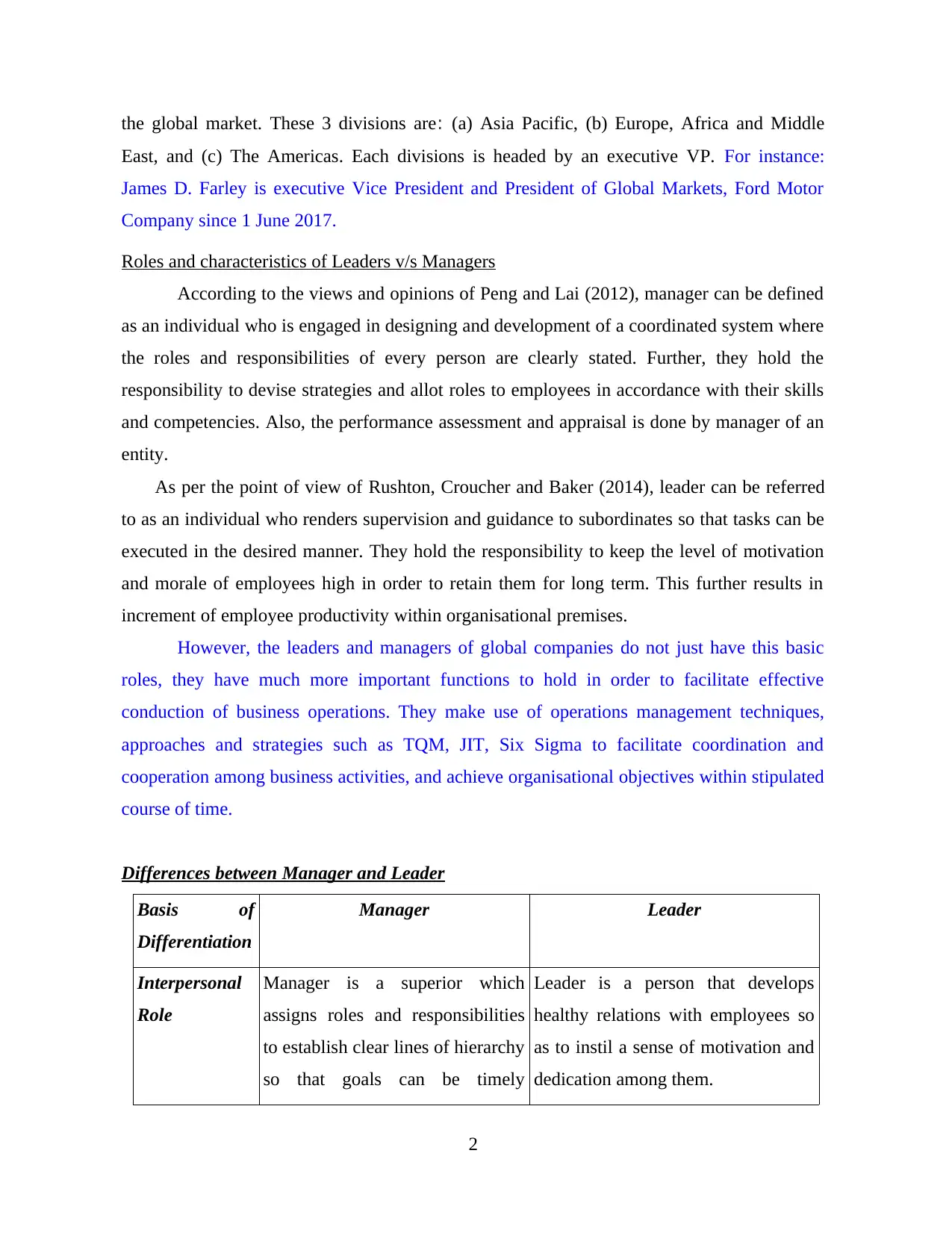
the global market. These 3 divisions are: (a) Asia Pacific, (b) Europe, Africa and Middle
East, and (c) The Americas. Each divisions is headed by an executive VP. For instance:
James D. Farley is executive Vice President and President of Global Markets, Ford Motor
Company since 1 June 2017.
Roles and characteristics of Leaders v/s Managers
According to the views and opinions of Peng and Lai (2012), manager can be defined
as an individual who is engaged in designing and development of a coordinated system where
the roles and responsibilities of every person are clearly stated. Further, they hold the
responsibility to devise strategies and allot roles to employees in accordance with their skills
and competencies. Also, the performance assessment and appraisal is done by manager of an
entity.
As per the point of view of Rushton, Croucher and Baker (2014), leader can be referred
to as an individual who renders supervision and guidance to subordinates so that tasks can be
executed in the desired manner. They hold the responsibility to keep the level of motivation
and morale of employees high in order to retain them for long term. This further results in
increment of employee productivity within organisational premises.
However, the leaders and managers of global companies do not just have this basic
roles, they have much more important functions to hold in order to facilitate effective
conduction of business operations. They make use of operations management techniques,
approaches and strategies such as TQM, JIT, Six Sigma to facilitate coordination and
cooperation among business activities, and achieve organisational objectives within stipulated
course of time.
Differences between Manager and Leader
Basis of
Differentiation
Manager Leader
Interpersonal
Role
Manager is a superior which
assigns roles and responsibilities
to establish clear lines of hierarchy
so that goals can be timely
Leader is a person that develops
healthy relations with employees so
as to instil a sense of motivation and
dedication among them.
2
East, and (c) The Americas. Each divisions is headed by an executive VP. For instance:
James D. Farley is executive Vice President and President of Global Markets, Ford Motor
Company since 1 June 2017.
Roles and characteristics of Leaders v/s Managers
According to the views and opinions of Peng and Lai (2012), manager can be defined
as an individual who is engaged in designing and development of a coordinated system where
the roles and responsibilities of every person are clearly stated. Further, they hold the
responsibility to devise strategies and allot roles to employees in accordance with their skills
and competencies. Also, the performance assessment and appraisal is done by manager of an
entity.
As per the point of view of Rushton, Croucher and Baker (2014), leader can be referred
to as an individual who renders supervision and guidance to subordinates so that tasks can be
executed in the desired manner. They hold the responsibility to keep the level of motivation
and morale of employees high in order to retain them for long term. This further results in
increment of employee productivity within organisational premises.
However, the leaders and managers of global companies do not just have this basic
roles, they have much more important functions to hold in order to facilitate effective
conduction of business operations. They make use of operations management techniques,
approaches and strategies such as TQM, JIT, Six Sigma to facilitate coordination and
cooperation among business activities, and achieve organisational objectives within stipulated
course of time.
Differences between Manager and Leader
Basis of
Differentiation
Manager Leader
Interpersonal
Role
Manager is a superior which
assigns roles and responsibilities
to establish clear lines of hierarchy
so that goals can be timely
Leader is a person that develops
healthy relations with employees so
as to instil a sense of motivation and
dedication among them.
2
Paraphrase This Document
Need a fresh take? Get an instant paraphrase of this document with our AI Paraphraser
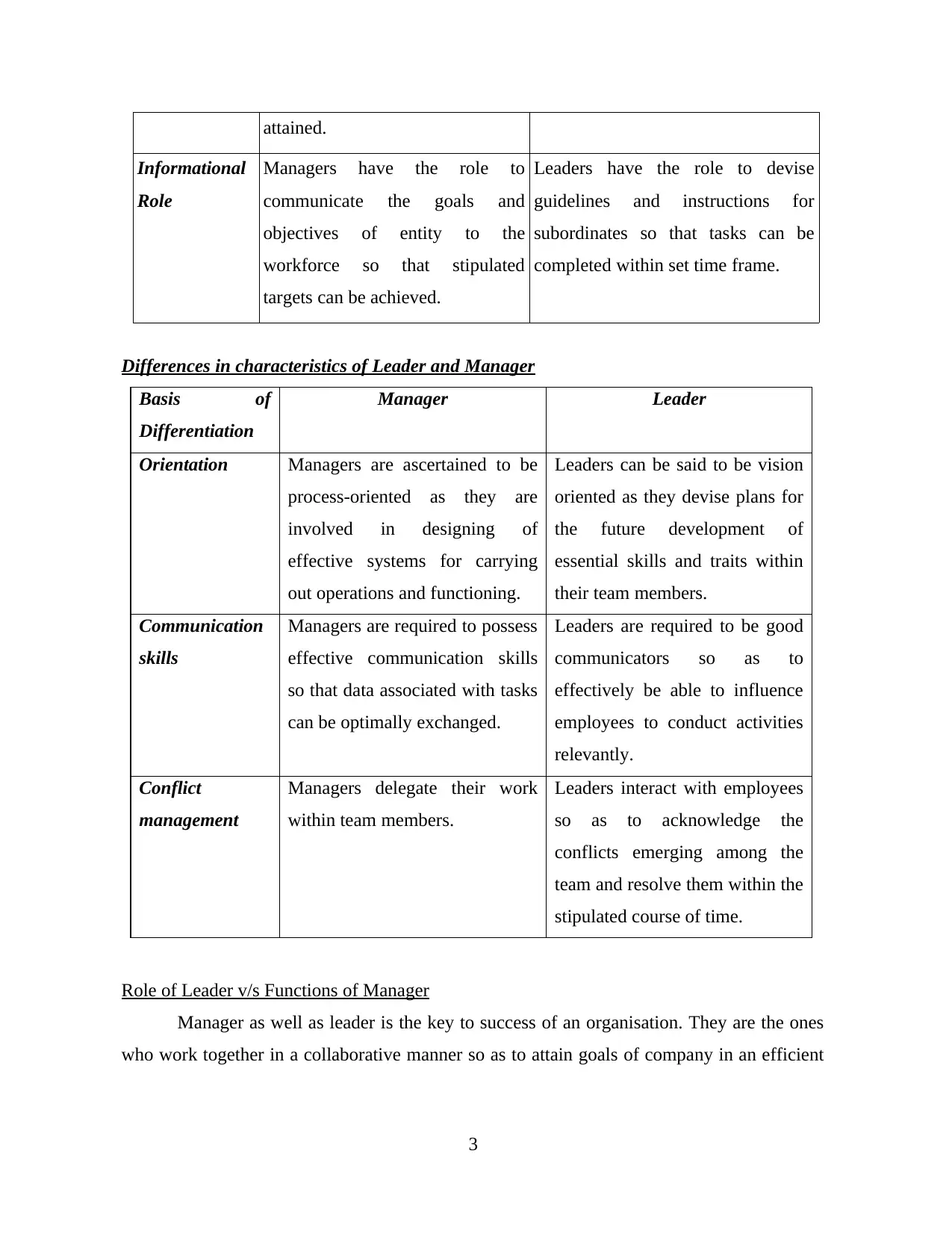
attained.
Informational
Role
Managers have the role to
communicate the goals and
objectives of entity to the
workforce so that stipulated
targets can be achieved.
Leaders have the role to devise
guidelines and instructions for
subordinates so that tasks can be
completed within set time frame.
Differences in characteristics of Leader and Manager
Basis of
Differentiation
Manager Leader
Orientation Managers are ascertained to be
process-oriented as they are
involved in designing of
effective systems for carrying
out operations and functioning.
Leaders can be said to be vision
oriented as they devise plans for
the future development of
essential skills and traits within
their team members.
Communication
skills
Managers are required to possess
effective communication skills
so that data associated with tasks
can be optimally exchanged.
Leaders are required to be good
communicators so as to
effectively be able to influence
employees to conduct activities
relevantly.
Conflict
management
Managers delegate their work
within team members.
Leaders interact with employees
so as to acknowledge the
conflicts emerging among the
team and resolve them within the
stipulated course of time.
Role of Leader v/s Functions of Manager
Manager as well as leader is the key to success of an organisation. They are the ones
who work together in a collaborative manner so as to attain goals of company in an efficient
3
Informational
Role
Managers have the role to
communicate the goals and
objectives of entity to the
workforce so that stipulated
targets can be achieved.
Leaders have the role to devise
guidelines and instructions for
subordinates so that tasks can be
completed within set time frame.
Differences in characteristics of Leader and Manager
Basis of
Differentiation
Manager Leader
Orientation Managers are ascertained to be
process-oriented as they are
involved in designing of
effective systems for carrying
out operations and functioning.
Leaders can be said to be vision
oriented as they devise plans for
the future development of
essential skills and traits within
their team members.
Communication
skills
Managers are required to possess
effective communication skills
so that data associated with tasks
can be optimally exchanged.
Leaders are required to be good
communicators so as to
effectively be able to influence
employees to conduct activities
relevantly.
Conflict
management
Managers delegate their work
within team members.
Leaders interact with employees
so as to acknowledge the
conflicts emerging among the
team and resolve them within the
stipulated course of time.
Role of Leader v/s Functions of Manager
Manager as well as leader is the key to success of an organisation. They are the ones
who work together in a collaborative manner so as to attain goals of company in an efficient
3
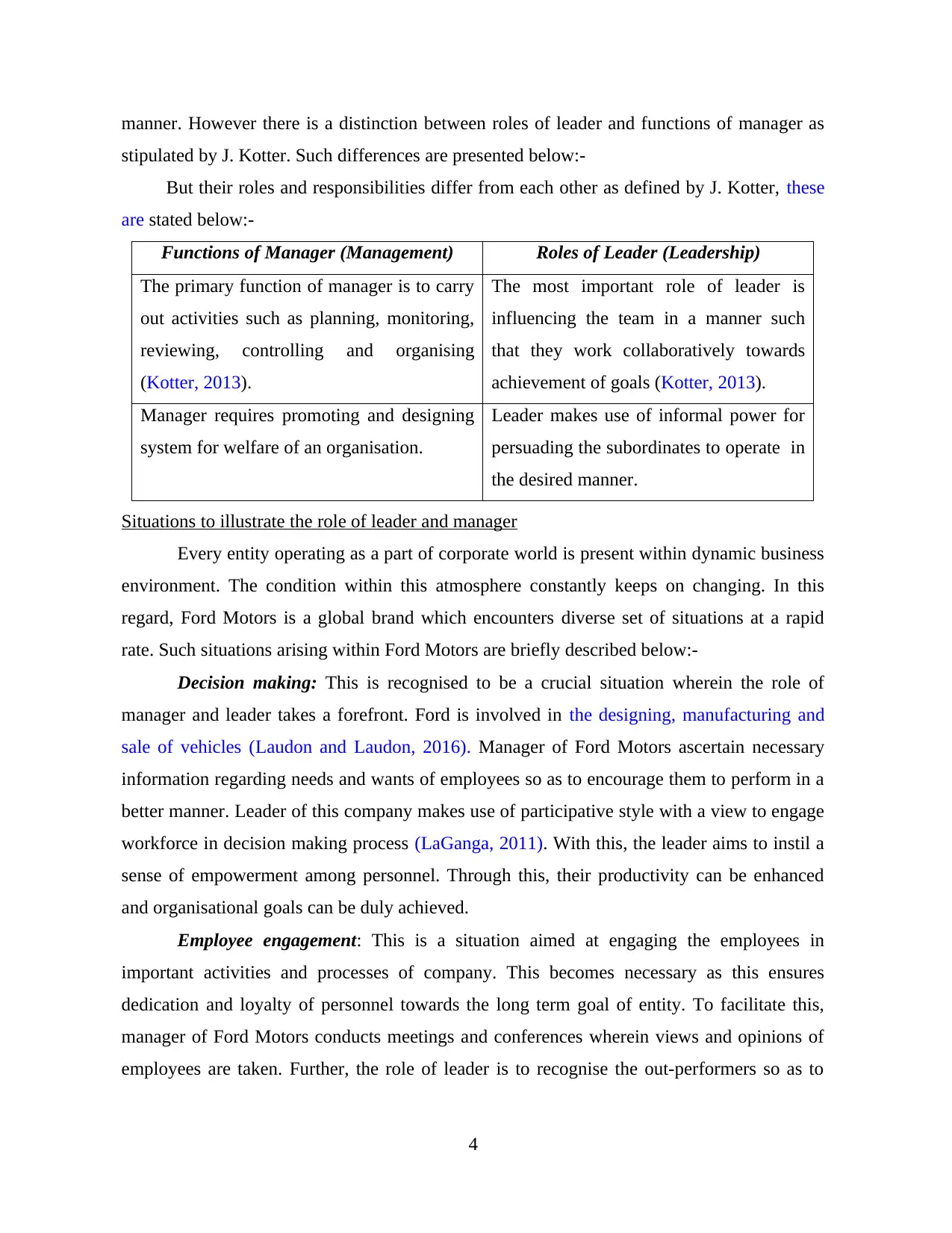
manner. However there is a distinction between roles of leader and functions of manager as
stipulated by J. Kotter. Such differences are presented below:-
But their roles and responsibilities differ from each other as defined by J. Kotter, these
are stated below:-
Functions of Manager (Management) Roles of Leader (Leadership)
The primary function of manager is to carry
out activities such as planning, monitoring,
reviewing, controlling and organising
(Kotter, 2013).
The most important role of leader is
influencing the team in a manner such
that they work collaboratively towards
achievement of goals (Kotter, 2013).
Manager requires promoting and designing
system for welfare of an organisation.
Leader makes use of informal power for
persuading the subordinates to operate in
the desired manner.
Situations to illustrate the role of leader and manager
Every entity operating as a part of corporate world is present within dynamic business
environment. The condition within this atmosphere constantly keeps on changing. In this
regard, Ford Motors is a global brand which encounters diverse set of situations at a rapid
rate. Such situations arising within Ford Motors are briefly described below:-
Decision making: This is recognised to be a crucial situation wherein the role of
manager and leader takes a forefront. Ford is involved in the designing, manufacturing and
sale of vehicles (Laudon and Laudon, 2016). Manager of Ford Motors ascertain necessary
information regarding needs and wants of employees so as to encourage them to perform in a
better manner. Leader of this company makes use of participative style with a view to engage
workforce in decision making process (LaGanga, 2011). With this, the leader aims to instil a
sense of empowerment among personnel. Through this, their productivity can be enhanced
and organisational goals can be duly achieved.
Employee engagement: This is a situation aimed at engaging the employees in
important activities and processes of company. This becomes necessary as this ensures
dedication and loyalty of personnel towards the long term goal of entity. To facilitate this,
manager of Ford Motors conducts meetings and conferences wherein views and opinions of
employees are taken. Further, the role of leader is to recognise the out-performers so as to
4
stipulated by J. Kotter. Such differences are presented below:-
But their roles and responsibilities differ from each other as defined by J. Kotter, these
are stated below:-
Functions of Manager (Management) Roles of Leader (Leadership)
The primary function of manager is to carry
out activities such as planning, monitoring,
reviewing, controlling and organising
(Kotter, 2013).
The most important role of leader is
influencing the team in a manner such
that they work collaboratively towards
achievement of goals (Kotter, 2013).
Manager requires promoting and designing
system for welfare of an organisation.
Leader makes use of informal power for
persuading the subordinates to operate in
the desired manner.
Situations to illustrate the role of leader and manager
Every entity operating as a part of corporate world is present within dynamic business
environment. The condition within this atmosphere constantly keeps on changing. In this
regard, Ford Motors is a global brand which encounters diverse set of situations at a rapid
rate. Such situations arising within Ford Motors are briefly described below:-
Decision making: This is recognised to be a crucial situation wherein the role of
manager and leader takes a forefront. Ford is involved in the designing, manufacturing and
sale of vehicles (Laudon and Laudon, 2016). Manager of Ford Motors ascertain necessary
information regarding needs and wants of employees so as to encourage them to perform in a
better manner. Leader of this company makes use of participative style with a view to engage
workforce in decision making process (LaGanga, 2011). With this, the leader aims to instil a
sense of empowerment among personnel. Through this, their productivity can be enhanced
and organisational goals can be duly achieved.
Employee engagement: This is a situation aimed at engaging the employees in
important activities and processes of company. This becomes necessary as this ensures
dedication and loyalty of personnel towards the long term goal of entity. To facilitate this,
manager of Ford Motors conducts meetings and conferences wherein views and opinions of
employees are taken. Further, the role of leader is to recognise the out-performers so as to
4
⊘ This is a preview!⊘
Do you want full access?
Subscribe today to unlock all pages.

Trusted by 1+ million students worldwide
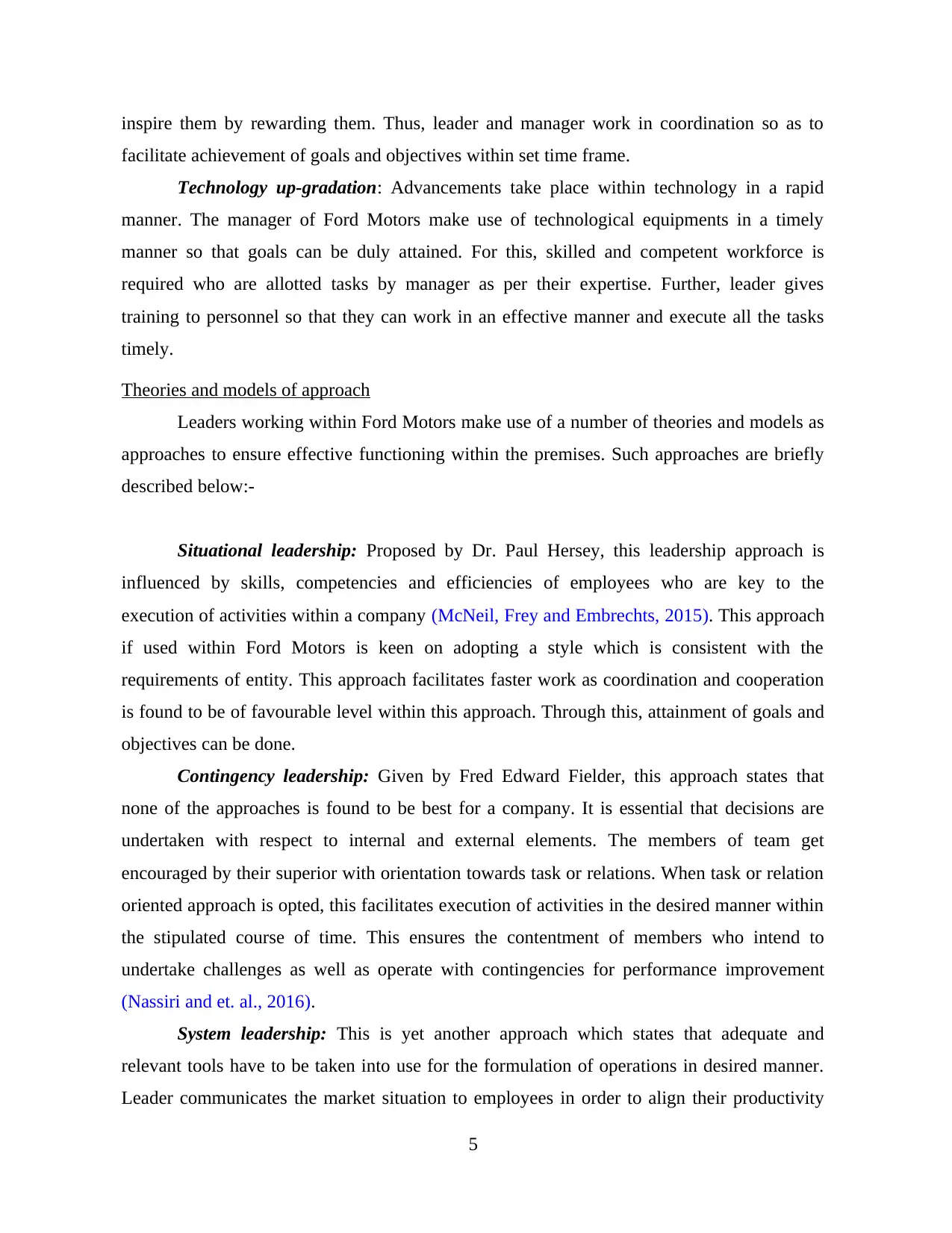
inspire them by rewarding them. Thus, leader and manager work in coordination so as to
facilitate achievement of goals and objectives within set time frame.
Technology up-gradation: Advancements take place within technology in a rapid
manner. The manager of Ford Motors make use of technological equipments in a timely
manner so that goals can be duly attained. For this, skilled and competent workforce is
required who are allotted tasks by manager as per their expertise. Further, leader gives
training to personnel so that they can work in an effective manner and execute all the tasks
timely.
Theories and models of approach
Leaders working within Ford Motors make use of a number of theories and models as
approaches to ensure effective functioning within the premises. Such approaches are briefly
described below:-
Situational leadership: Proposed by Dr. Paul Hersey, this leadership approach is
influenced by skills, competencies and efficiencies of employees who are key to the
execution of activities within a company (McNeil, Frey and Embrechts, 2015). This approach
if used within Ford Motors is keen on adopting a style which is consistent with the
requirements of entity. This approach facilitates faster work as coordination and cooperation
is found to be of favourable level within this approach. Through this, attainment of goals and
objectives can be done.
Contingency leadership: Given by Fred Edward Fielder, this approach states that
none of the approaches is found to be best for a company. It is essential that decisions are
undertaken with respect to internal and external elements. The members of team get
encouraged by their superior with orientation towards task or relations. When task or relation
oriented approach is opted, this facilitates execution of activities in the desired manner within
the stipulated course of time. This ensures the contentment of members who intend to
undertake challenges as well as operate with contingencies for performance improvement
(Nassiri and et. al., 2016).
System leadership: This is yet another approach which states that adequate and
relevant tools have to be taken into use for the formulation of operations in desired manner.
Leader communicates the market situation to employees in order to align their productivity
5
facilitate achievement of goals and objectives within set time frame.
Technology up-gradation: Advancements take place within technology in a rapid
manner. The manager of Ford Motors make use of technological equipments in a timely
manner so that goals can be duly attained. For this, skilled and competent workforce is
required who are allotted tasks by manager as per their expertise. Further, leader gives
training to personnel so that they can work in an effective manner and execute all the tasks
timely.
Theories and models of approach
Leaders working within Ford Motors make use of a number of theories and models as
approaches to ensure effective functioning within the premises. Such approaches are briefly
described below:-
Situational leadership: Proposed by Dr. Paul Hersey, this leadership approach is
influenced by skills, competencies and efficiencies of employees who are key to the
execution of activities within a company (McNeil, Frey and Embrechts, 2015). This approach
if used within Ford Motors is keen on adopting a style which is consistent with the
requirements of entity. This approach facilitates faster work as coordination and cooperation
is found to be of favourable level within this approach. Through this, attainment of goals and
objectives can be done.
Contingency leadership: Given by Fred Edward Fielder, this approach states that
none of the approaches is found to be best for a company. It is essential that decisions are
undertaken with respect to internal and external elements. The members of team get
encouraged by their superior with orientation towards task or relations. When task or relation
oriented approach is opted, this facilitates execution of activities in the desired manner within
the stipulated course of time. This ensures the contentment of members who intend to
undertake challenges as well as operate with contingencies for performance improvement
(Nassiri and et. al., 2016).
System leadership: This is yet another approach which states that adequate and
relevant tools have to be taken into use for the formulation of operations in desired manner.
Leader communicates the market situation to employees in order to align their productivity
5
Paraphrase This Document
Need a fresh take? Get an instant paraphrase of this document with our AI Paraphraser
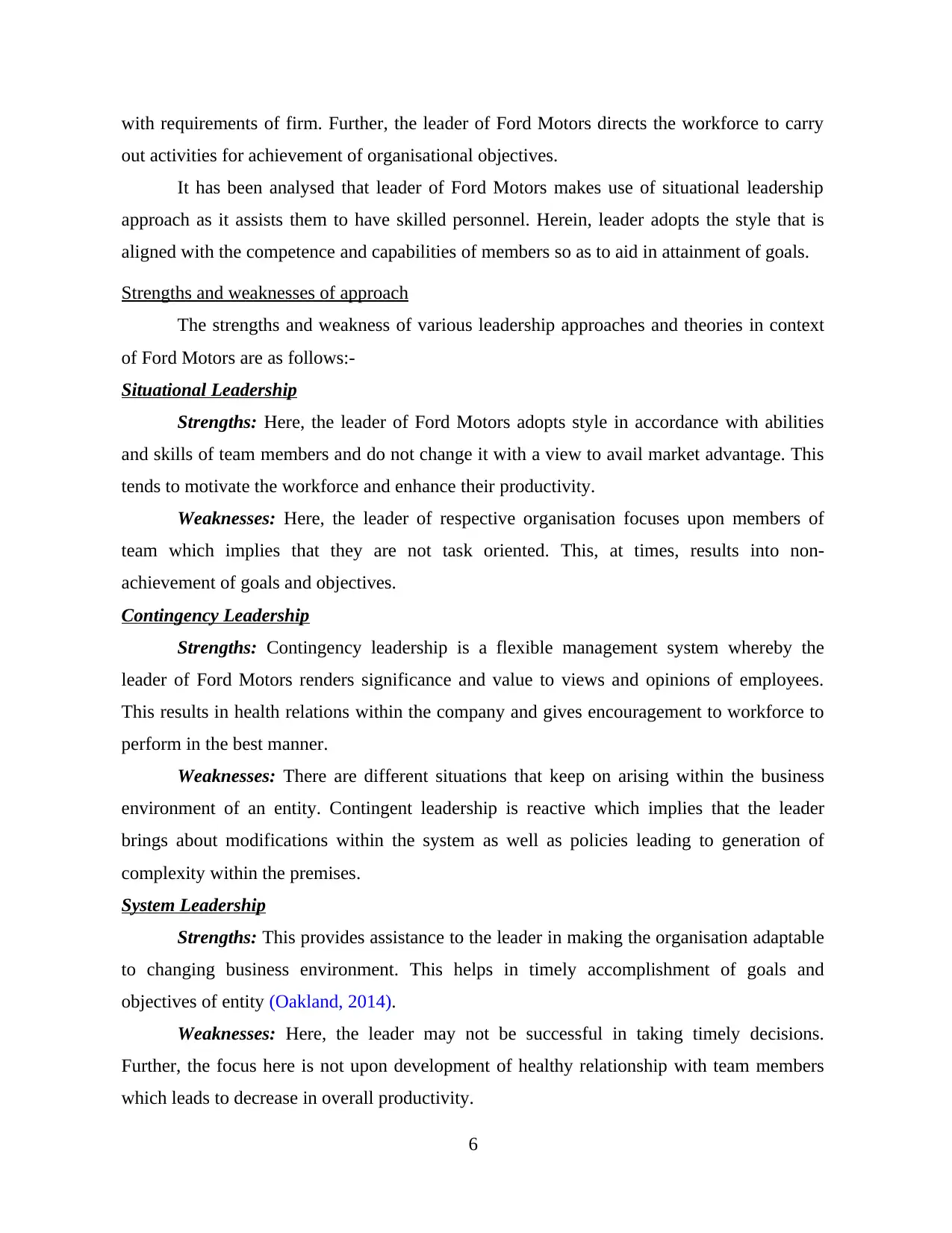
with requirements of firm. Further, the leader of Ford Motors directs the workforce to carry
out activities for achievement of organisational objectives.
It has been analysed that leader of Ford Motors makes use of situational leadership
approach as it assists them to have skilled personnel. Herein, leader adopts the style that is
aligned with the competence and capabilities of members so as to aid in attainment of goals.
Strengths and weaknesses of approach
The strengths and weakness of various leadership approaches and theories in context
of Ford Motors are as follows:-
Situational Leadership
Strengths: Here, the leader of Ford Motors adopts style in accordance with abilities
and skills of team members and do not change it with a view to avail market advantage. This
tends to motivate the workforce and enhance their productivity.
Weaknesses: Here, the leader of respective organisation focuses upon members of
team which implies that they are not task oriented. This, at times, results into non-
achievement of goals and objectives.
Contingency Leadership
Strengths: Contingency leadership is a flexible management system whereby the
leader of Ford Motors renders significance and value to views and opinions of employees.
This results in health relations within the company and gives encouragement to workforce to
perform in the best manner.
Weaknesses: There are different situations that keep on arising within the business
environment of an entity. Contingent leadership is reactive which implies that the leader
brings about modifications within the system as well as policies leading to generation of
complexity within the premises.
System Leadership
Strengths: This provides assistance to the leader in making the organisation adaptable
to changing business environment. This helps in timely accomplishment of goals and
objectives of entity (Oakland, 2014).
Weaknesses: Here, the leader may not be successful in taking timely decisions.
Further, the focus here is not upon development of healthy relationship with team members
which leads to decrease in overall productivity.
6
out activities for achievement of organisational objectives.
It has been analysed that leader of Ford Motors makes use of situational leadership
approach as it assists them to have skilled personnel. Herein, leader adopts the style that is
aligned with the competence and capabilities of members so as to aid in attainment of goals.
Strengths and weaknesses of approach
The strengths and weakness of various leadership approaches and theories in context
of Ford Motors are as follows:-
Situational Leadership
Strengths: Here, the leader of Ford Motors adopts style in accordance with abilities
and skills of team members and do not change it with a view to avail market advantage. This
tends to motivate the workforce and enhance their productivity.
Weaknesses: Here, the leader of respective organisation focuses upon members of
team which implies that they are not task oriented. This, at times, results into non-
achievement of goals and objectives.
Contingency Leadership
Strengths: Contingency leadership is a flexible management system whereby the
leader of Ford Motors renders significance and value to views and opinions of employees.
This results in health relations within the company and gives encouragement to workforce to
perform in the best manner.
Weaknesses: There are different situations that keep on arising within the business
environment of an entity. Contingent leadership is reactive which implies that the leader
brings about modifications within the system as well as policies leading to generation of
complexity within the premises.
System Leadership
Strengths: This provides assistance to the leader in making the organisation adaptable
to changing business environment. This helps in timely accomplishment of goals and
objectives of entity (Oakland, 2014).
Weaknesses: Here, the leader may not be successful in taking timely decisions.
Further, the focus here is not upon development of healthy relationship with team members
which leads to decrease in overall productivity.
6
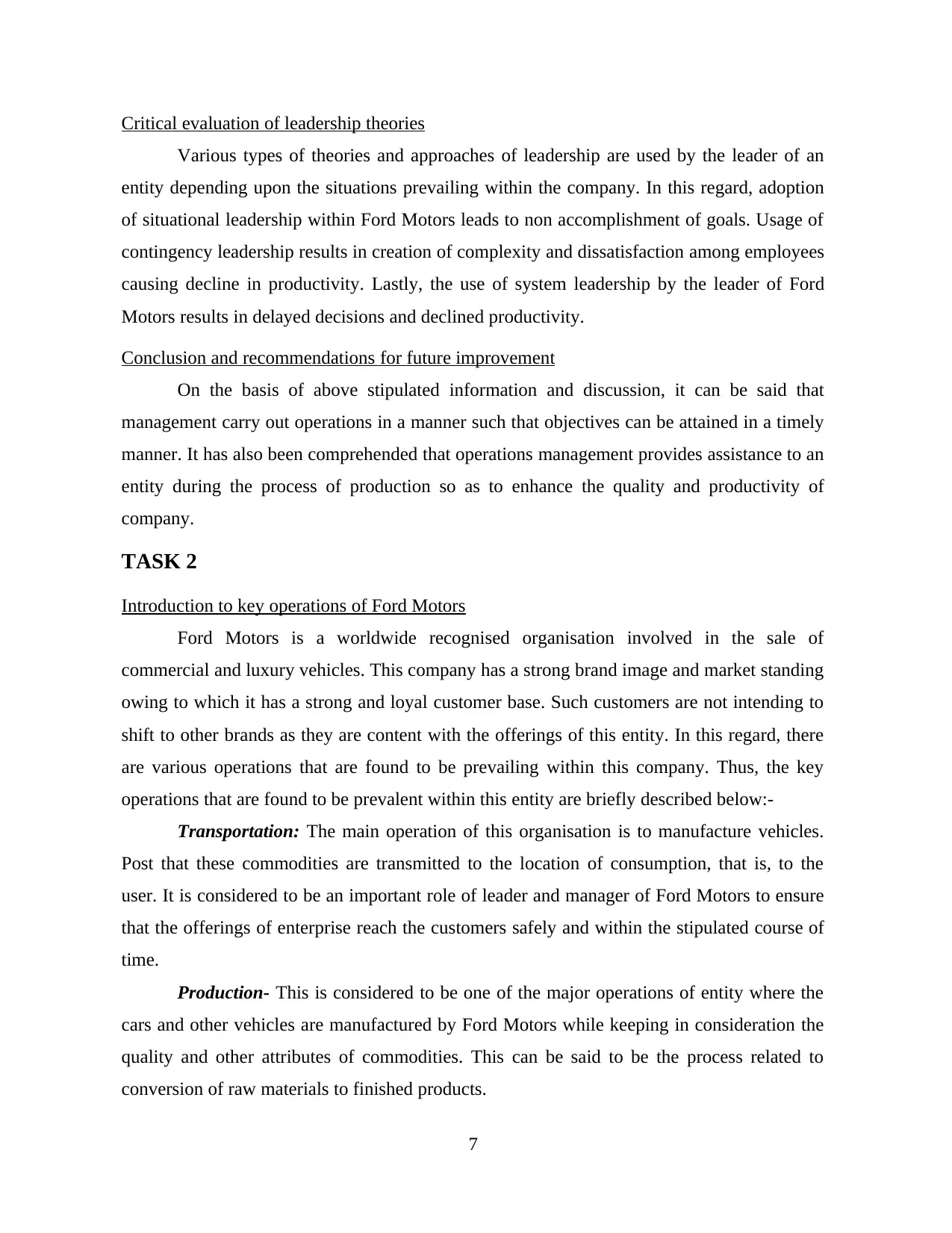
Critical evaluation of leadership theories
Various types of theories and approaches of leadership are used by the leader of an
entity depending upon the situations prevailing within the company. In this regard, adoption
of situational leadership within Ford Motors leads to non accomplishment of goals. Usage of
contingency leadership results in creation of complexity and dissatisfaction among employees
causing decline in productivity. Lastly, the use of system leadership by the leader of Ford
Motors results in delayed decisions and declined productivity.
Conclusion and recommendations for future improvement
On the basis of above stipulated information and discussion, it can be said that
management carry out operations in a manner such that objectives can be attained in a timely
manner. It has also been comprehended that operations management provides assistance to an
entity during the process of production so as to enhance the quality and productivity of
company.
TASK 2
Introduction to key operations of Ford Motors
Ford Motors is a worldwide recognised organisation involved in the sale of
commercial and luxury vehicles. This company has a strong brand image and market standing
owing to which it has a strong and loyal customer base. Such customers are not intending to
shift to other brands as they are content with the offerings of this entity. In this regard, there
are various operations that are found to be prevailing within this company. Thus, the key
operations that are found to be prevalent within this entity are briefly described below:-
Transportation: The main operation of this organisation is to manufacture vehicles.
Post that these commodities are transmitted to the location of consumption, that is, to the
user. It is considered to be an important role of leader and manager of Ford Motors to ensure
that the offerings of enterprise reach the customers safely and within the stipulated course of
time.
Production- This is considered to be one of the major operations of entity where the
cars and other vehicles are manufactured by Ford Motors while keeping in consideration the
quality and other attributes of commodities. This can be said to be the process related to
conversion of raw materials to finished products.
7
Various types of theories and approaches of leadership are used by the leader of an
entity depending upon the situations prevailing within the company. In this regard, adoption
of situational leadership within Ford Motors leads to non accomplishment of goals. Usage of
contingency leadership results in creation of complexity and dissatisfaction among employees
causing decline in productivity. Lastly, the use of system leadership by the leader of Ford
Motors results in delayed decisions and declined productivity.
Conclusion and recommendations for future improvement
On the basis of above stipulated information and discussion, it can be said that
management carry out operations in a manner such that objectives can be attained in a timely
manner. It has also been comprehended that operations management provides assistance to an
entity during the process of production so as to enhance the quality and productivity of
company.
TASK 2
Introduction to key operations of Ford Motors
Ford Motors is a worldwide recognised organisation involved in the sale of
commercial and luxury vehicles. This company has a strong brand image and market standing
owing to which it has a strong and loyal customer base. Such customers are not intending to
shift to other brands as they are content with the offerings of this entity. In this regard, there
are various operations that are found to be prevailing within this company. Thus, the key
operations that are found to be prevalent within this entity are briefly described below:-
Transportation: The main operation of this organisation is to manufacture vehicles.
Post that these commodities are transmitted to the location of consumption, that is, to the
user. It is considered to be an important role of leader and manager of Ford Motors to ensure
that the offerings of enterprise reach the customers safely and within the stipulated course of
time.
Production- This is considered to be one of the major operations of entity where the
cars and other vehicles are manufactured by Ford Motors while keeping in consideration the
quality and other attributes of commodities. This can be said to be the process related to
conversion of raw materials to finished products.
7
⊘ This is a preview!⊘
Do you want full access?
Subscribe today to unlock all pages.

Trusted by 1+ million students worldwide
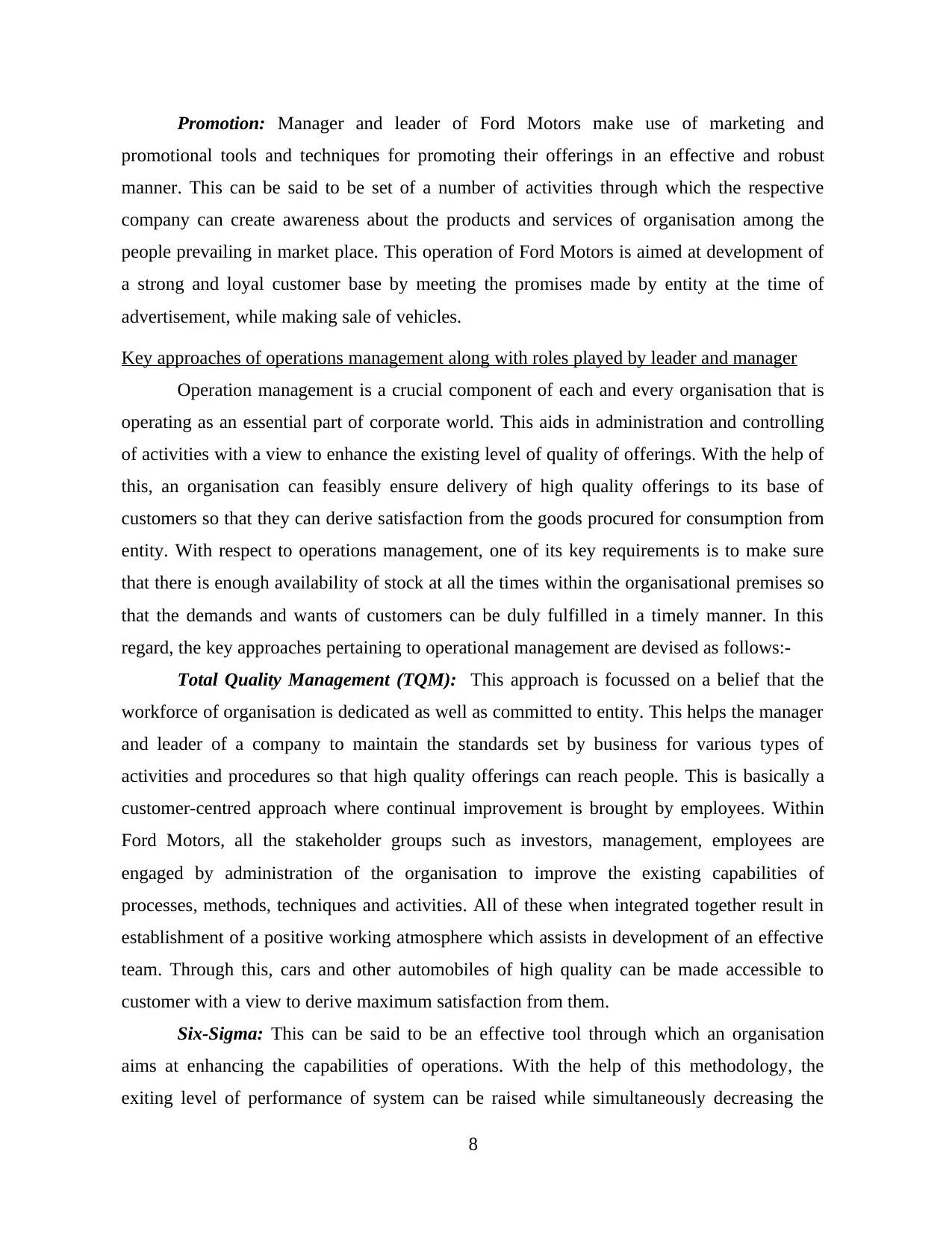
Promotion: Manager and leader of Ford Motors make use of marketing and
promotional tools and techniques for promoting their offerings in an effective and robust
manner. This can be said to be set of a number of activities through which the respective
company can create awareness about the products and services of organisation among the
people prevailing in market place. This operation of Ford Motors is aimed at development of
a strong and loyal customer base by meeting the promises made by entity at the time of
advertisement, while making sale of vehicles.
Key approaches of operations management along with roles played by leader and manager
Operation management is a crucial component of each and every organisation that is
operating as an essential part of corporate world. This aids in administration and controlling
of activities with a view to enhance the existing level of quality of offerings. With the help of
this, an organisation can feasibly ensure delivery of high quality offerings to its base of
customers so that they can derive satisfaction from the goods procured for consumption from
entity. With respect to operations management, one of its key requirements is to make sure
that there is enough availability of stock at all the times within the organisational premises so
that the demands and wants of customers can be duly fulfilled in a timely manner. In this
regard, the key approaches pertaining to operational management are devised as follows:-
Total Quality Management (TQM): This approach is focussed on a belief that the
workforce of organisation is dedicated as well as committed to entity. This helps the manager
and leader of a company to maintain the standards set by business for various types of
activities and procedures so that high quality offerings can reach people. This is basically a
customer-centred approach where continual improvement is brought by employees. Within
Ford Motors, all the stakeholder groups such as investors, management, employees are
engaged by administration of the organisation to improve the existing capabilities of
processes, methods, techniques and activities. All of these when integrated together result in
establishment of a positive working atmosphere which assists in development of an effective
team. Through this, cars and other automobiles of high quality can be made accessible to
customer with a view to derive maximum satisfaction from them.
Six-Sigma: This can be said to be an effective tool through which an organisation
aims at enhancing the capabilities of operations. With the help of this methodology, the
exiting level of performance of system can be raised while simultaneously decreasing the
8
promotional tools and techniques for promoting their offerings in an effective and robust
manner. This can be said to be set of a number of activities through which the respective
company can create awareness about the products and services of organisation among the
people prevailing in market place. This operation of Ford Motors is aimed at development of
a strong and loyal customer base by meeting the promises made by entity at the time of
advertisement, while making sale of vehicles.
Key approaches of operations management along with roles played by leader and manager
Operation management is a crucial component of each and every organisation that is
operating as an essential part of corporate world. This aids in administration and controlling
of activities with a view to enhance the existing level of quality of offerings. With the help of
this, an organisation can feasibly ensure delivery of high quality offerings to its base of
customers so that they can derive satisfaction from the goods procured for consumption from
entity. With respect to operations management, one of its key requirements is to make sure
that there is enough availability of stock at all the times within the organisational premises so
that the demands and wants of customers can be duly fulfilled in a timely manner. In this
regard, the key approaches pertaining to operational management are devised as follows:-
Total Quality Management (TQM): This approach is focussed on a belief that the
workforce of organisation is dedicated as well as committed to entity. This helps the manager
and leader of a company to maintain the standards set by business for various types of
activities and procedures so that high quality offerings can reach people. This is basically a
customer-centred approach where continual improvement is brought by employees. Within
Ford Motors, all the stakeholder groups such as investors, management, employees are
engaged by administration of the organisation to improve the existing capabilities of
processes, methods, techniques and activities. All of these when integrated together result in
establishment of a positive working atmosphere which assists in development of an effective
team. Through this, cars and other automobiles of high quality can be made accessible to
customer with a view to derive maximum satisfaction from them.
Six-Sigma: This can be said to be an effective tool through which an organisation
aims at enhancing the capabilities of operations. With the help of this methodology, the
exiting level of performance of system can be raised while simultaneously decreasing the
8
Paraphrase This Document
Need a fresh take? Get an instant paraphrase of this document with our AI Paraphraser
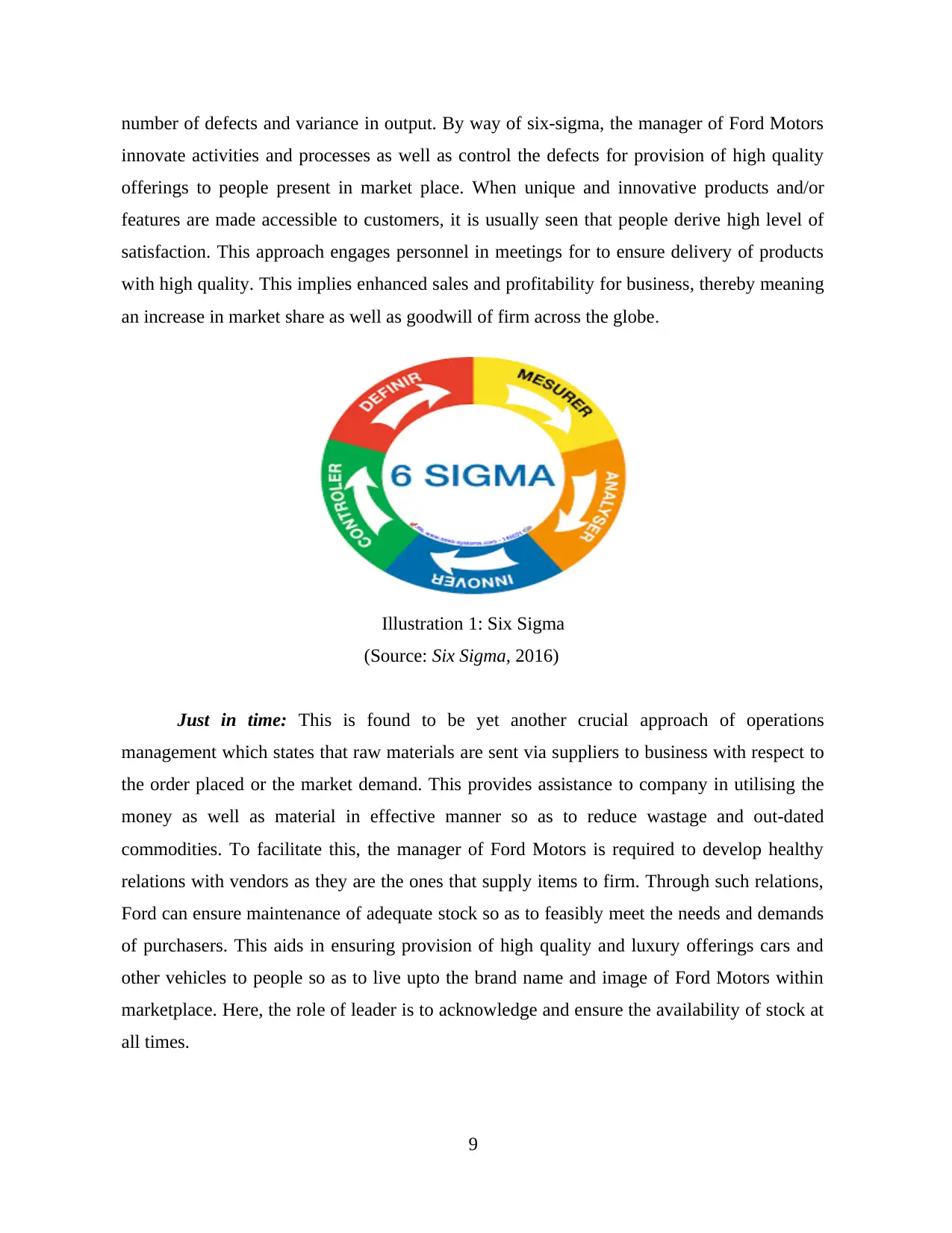
number of defects and variance in output. By way of six-sigma, the manager of Ford Motors
innovate activities and processes as well as control the defects for provision of high quality
offerings to people present in market place. When unique and innovative products and/or
features are made accessible to customers, it is usually seen that people derive high level of
satisfaction. This approach engages personnel in meetings for to ensure delivery of products
with high quality. This implies enhanced sales and profitability for business, thereby meaning
an increase in market share as well as goodwill of firm across the globe.
(Source: Six Sigma, 2016)
Just in time: This is found to be yet another crucial approach of operations
management which states that raw materials are sent via suppliers to business with respect to
the order placed or the market demand. This provides assistance to company in utilising the
money as well as material in effective manner so as to reduce wastage and out-dated
commodities. To facilitate this, the manager of Ford Motors is required to develop healthy
relations with vendors as they are the ones that supply items to firm. Through such relations,
Ford can ensure maintenance of adequate stock so as to feasibly meet the needs and demands
of purchasers. This aids in ensuring provision of high quality and luxury offerings cars and
other vehicles to people so as to live upto the brand name and image of Ford Motors within
marketplace. Here, the role of leader is to acknowledge and ensure the availability of stock at
all times.
9
Illustration 1: Six Sigma
innovate activities and processes as well as control the defects for provision of high quality
offerings to people present in market place. When unique and innovative products and/or
features are made accessible to customers, it is usually seen that people derive high level of
satisfaction. This approach engages personnel in meetings for to ensure delivery of products
with high quality. This implies enhanced sales and profitability for business, thereby meaning
an increase in market share as well as goodwill of firm across the globe.
(Source: Six Sigma, 2016)
Just in time: This is found to be yet another crucial approach of operations
management which states that raw materials are sent via suppliers to business with respect to
the order placed or the market demand. This provides assistance to company in utilising the
money as well as material in effective manner so as to reduce wastage and out-dated
commodities. To facilitate this, the manager of Ford Motors is required to develop healthy
relations with vendors as they are the ones that supply items to firm. Through such relations,
Ford can ensure maintenance of adequate stock so as to feasibly meet the needs and demands
of purchasers. This aids in ensuring provision of high quality and luxury offerings cars and
other vehicles to people so as to live upto the brand name and image of Ford Motors within
marketplace. Here, the role of leader is to acknowledge and ensure the availability of stock at
all times.
9
Illustration 1: Six Sigma
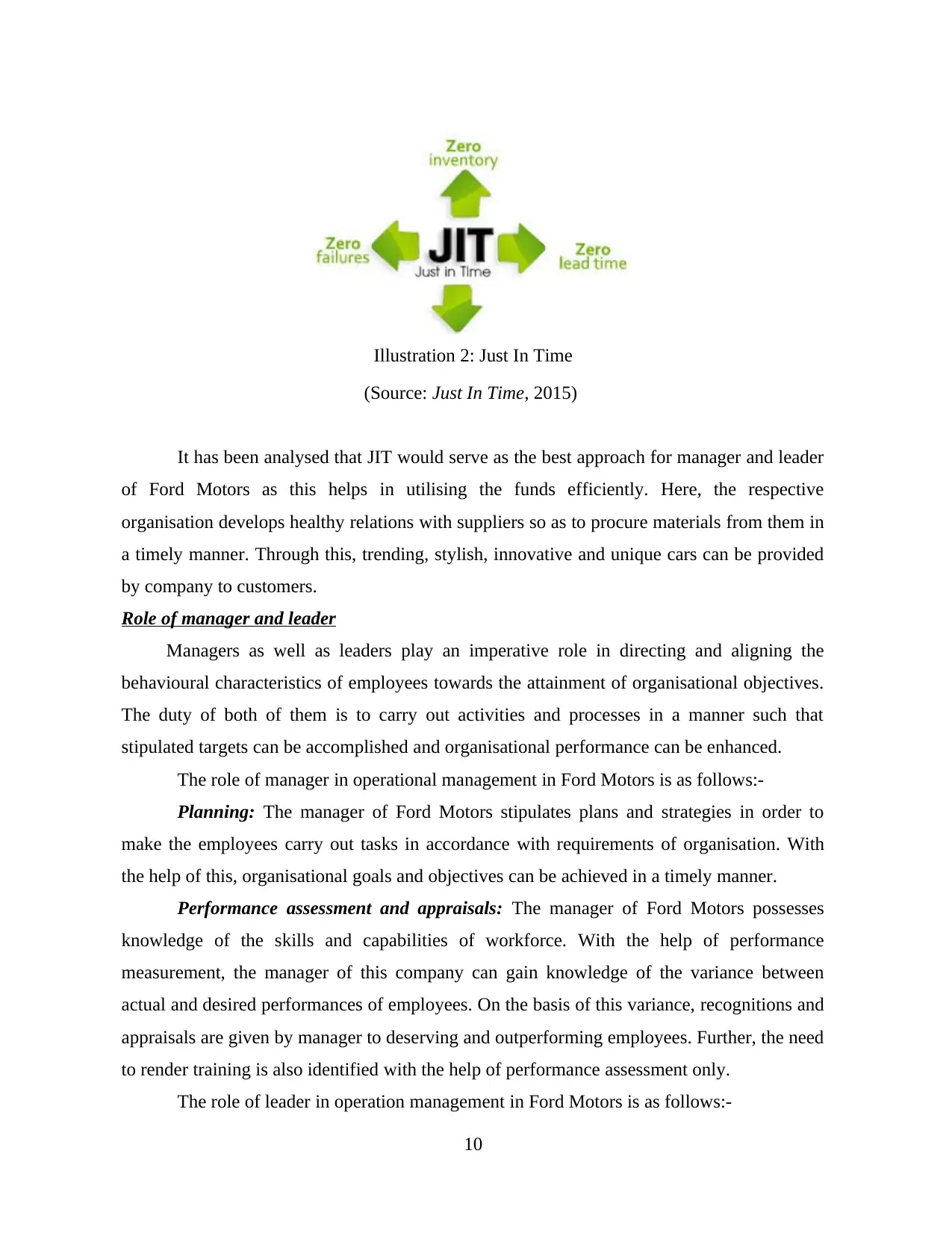
(Source: Just In Time, 2015)
It has been analysed that JIT would serve as the best approach for manager and leader
of Ford Motors as this helps in utilising the funds efficiently. Here, the respective
organisation develops healthy relations with suppliers so as to procure materials from them in
a timely manner. Through this, trending, stylish, innovative and unique cars can be provided
by company to customers.
Role of manager and leader
Managers as well as leaders play an imperative role in directing and aligning the
behavioural characteristics of employees towards the attainment of organisational objectives.
The duty of both of them is to carry out activities and processes in a manner such that
stipulated targets can be accomplished and organisational performance can be enhanced.
The role of manager in operational management in Ford Motors is as follows:-
Planning: The manager of Ford Motors stipulates plans and strategies in order to
make the employees carry out tasks in accordance with requirements of organisation. With
the help of this, organisational goals and objectives can be achieved in a timely manner.
Performance assessment and appraisals: The manager of Ford Motors possesses
knowledge of the skills and capabilities of workforce. With the help of performance
measurement, the manager of this company can gain knowledge of the variance between
actual and desired performances of employees. On the basis of this variance, recognitions and
appraisals are given by manager to deserving and outperforming employees. Further, the need
to render training is also identified with the help of performance assessment only.
The role of leader in operation management in Ford Motors is as follows:-
10
Illustration 2: Just In Time
It has been analysed that JIT would serve as the best approach for manager and leader
of Ford Motors as this helps in utilising the funds efficiently. Here, the respective
organisation develops healthy relations with suppliers so as to procure materials from them in
a timely manner. Through this, trending, stylish, innovative and unique cars can be provided
by company to customers.
Role of manager and leader
Managers as well as leaders play an imperative role in directing and aligning the
behavioural characteristics of employees towards the attainment of organisational objectives.
The duty of both of them is to carry out activities and processes in a manner such that
stipulated targets can be accomplished and organisational performance can be enhanced.
The role of manager in operational management in Ford Motors is as follows:-
Planning: The manager of Ford Motors stipulates plans and strategies in order to
make the employees carry out tasks in accordance with requirements of organisation. With
the help of this, organisational goals and objectives can be achieved in a timely manner.
Performance assessment and appraisals: The manager of Ford Motors possesses
knowledge of the skills and capabilities of workforce. With the help of performance
measurement, the manager of this company can gain knowledge of the variance between
actual and desired performances of employees. On the basis of this variance, recognitions and
appraisals are given by manager to deserving and outperforming employees. Further, the need
to render training is also identified with the help of performance assessment only.
The role of leader in operation management in Ford Motors is as follows:-
10
Illustration 2: Just In Time
⊘ This is a preview!⊘
Do you want full access?
Subscribe today to unlock all pages.

Trusted by 1+ million students worldwide
1 out of 16
Related Documents
Your All-in-One AI-Powered Toolkit for Academic Success.
+13062052269
info@desklib.com
Available 24*7 on WhatsApp / Email
![[object Object]](/_next/static/media/star-bottom.7253800d.svg)
Unlock your academic potential
Copyright © 2020–2025 A2Z Services. All Rights Reserved. Developed and managed by ZUCOL.




